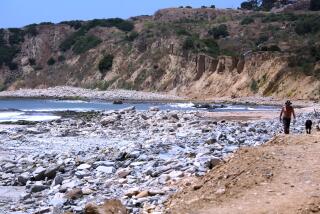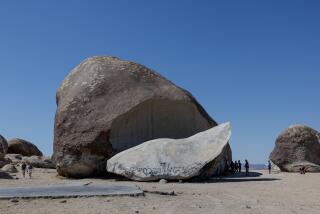Fleeting Footprints of Hollywood Crisscross White Sands : New Mexico: Dunes draw 600,000 visitors a year, including movie-makers and hikers. One of the biggest problems is the straight-horned oryx, imported from Africa to provide hunters with trophies.
WHITE SANDS NATIONAL MONUMENT, N.M. â Itâs a sand machine, a light show, a misbegotten haven for African antelope, a filmmakerâs mecca.
Hikers come to these shimmering dunes looking to lose civilization, only to lose themselves. Even their footprints vanish.
These sands draw 600,000 visitors a year and, as sands go, are relatively young, the remains of an ocean that covered the area 250 million years ago.
The tiny, sparkling crystals of gypsum are uncovered daily in a cycle that churns them up with help from mountain streams and desert winds.
After sunrise, the dunes seem to move as the rising sun evokes shadows that slink across them. At sunset, clouds hang like molten ingots over the San Andreas Mountains. The winds pick up, sending a ghostly nimbus of sand flowing just above the surface.
âWe have people lost very frequently. Thatâs one of my biggest challenges,â said ranger Kathy Denton. âThey arenât used to big, open spaces. They get awe-struck. They want to get this picture. They have no idea where they are. They panic.â
Denton had 11 rescues last year.
Her other big task involves the film industry. Actress Ali MacGraw did her yoga video here last June. Recently, Boyz II Men did a music video, and Detroit Pistons basketball star Grant Hill slam-dunked for a shoe commercial.
The movie industry, which has been filming Westerns here for decades, is the largest commercial user of White Sands. Forty commercial filming ventures, including two movies, were shot here last year. So far, a dozen projects have been filmed this year.
Denton said producers often seek exemption from park rules, especially pertaining to vehicles.
âThey ask to do things we cannot allow them to do because we are protecting the resource, but once we explain our position, they comply,â she said.
She makes sure a park official watches every move--at the producerâs expense.
The Academy of Motion Picture Arts and Sciences and the New Mexico Film Commission say at least 10 feature films have been shot at the park since 1974, including âStar Warsâ in 1977, âYoung Guns IIâ in 1990, âTank Girl,â which just came out, and the still-to-be-released âMad Love,â filmed in 1994.
The 220-square-mile park was founded in 1933 on the executive order of President Herbert Hoover. One of its biggest problems, the straight-horned oryx--an imported African antelope of sometimes aggressive demeanor--was created by manâs whim. Now the park is building a $1-million, 64-mile fence to keep the critters out.
The state Game and Fish Department brought in 100 of the antelopes to the adjacent White Sands Missile Range as game for sports hunters in 1969. They now number between 1,600 and 2,000 and threaten the pristine dunes park, according to resources manager Bill Fuchs.
Oryx at the missile range âwere introduced under vigorous protest by the Bureau of Land Management, which warned: âIf you introduce these animals, their populationâs going to grow, theyâre going to expand out and come onto other lands and create management problems.â They were very prophetic,â Fuchs said.
The BLS already had faced problems with mustangs and burros.
Rangers also hope the fence will block dangerous confrontations between visitors and the 850-pound bucks during rutting season. In the heat of the breeding season the oryx have been known to charge pickup trucks. In Texas, where oryx were brought into game parks, the oryx is the No. 2 hazard to visitors. No. 1 is the African lion, which also preys on the oryx.
Since 1985, about 20 miles of fence have been built. The final phase is under way. Ultimately, the oryx will be driven off the park. Hunters take up to 400 oryx a year, but still their population grows.
The oryx are drawn by the abundant grasses and other plant life that sprout between the dunes, Fuchs said. But they also trample the hundreds of archeological sites and artifacts, sensitive plant life and the anti-erosive crusts that protect the dunes.
The sands have been forming here for about 15,000 years and attracting people for at least 2,000 years. Fuchs said known sites associated with the ancient Jornada Mogollon Indians date back about 1,200 years, while Mescalero Apaches arrived about 200 years ago.
Spiritual leaders of the Mescalero are allowed to gather plants traditionally used in Mescalero ceremonies, said park Supt. Dennis Ditmanson.
âA lot of our visitors come for the austere beauty, the sense of isolation, the sense of aloneness--those kinds of emotions that this empty place can generate,â Ditmanson said.
âAt the same time, a lot of people come for the recreational aspects. They come to hike, they come to slide down the dunes, they come to picnic--family kinds of activities. And the park is big enough to accommodate those somewhat disparate uses.â
âWinds come along, and the next day you would swear no one had ever been on the dunes before,â Fuchs said.
Where do the dunes come from?
âItâs actually a very simple story,â Fuchs said. âThe mountains on either side are capped with (prehistoric) ocean deposits that contain abundant gypsum. Water from rain and snow percolate down through those deposits, dissolve minute amounts of that gypsum and carry it down into the basin.
âSince this is a closed basin--there are no rivers or streams running out of it--all that water stays within the basin except what evaporates off. All the minerals that were carried down by that water get left behind as the water evaporates.â
Briny Lake Lucero, southwest of here, is the remnant of ancient Lake Otero, which largely filled the Tularosa Basin. As the lake shrank, gypsum crystals began forming about 15,000 years ago.
âIt is sand--basically a particle of rock or mineral that is large enough so the wind will not pick it up and carry it away, as it does dust--and small enough that the wind can move it, usually by bouncing it along the surface.
âSand grains, even in very strong winds, are rarely carried more than a foot or two above the surface. And then they fall, and thatâs essentially how sand dunes form.â
Some gypsum crystals are larger--Fuchs has one 3-foot crystal. Theyâre nearly as soft as soap. The erosive action of the gritty, sand-laden wind eventually breaks them down into smaller crystals--more sand.
Larger amber-colored crystals, called selenite, often form in the muds of Lake Lucero.
âThe selenite beds of Lake Lucero have been famous since the 1800s,â Fuchs said. âThere are hundreds of thousands of crystals, most of them on the order of 4 inches up to about a foot long. . . . In the sun, it looks like thereâs a large area covered with broken glass.â
Some early European settlers used panes of translucent selenite for primitive windows, he said.
Crystals also form under the dunes. Itâs illegal to take them.
More to Read
Sign up for The Wild
Weâll help you find the best places to hike, bike and run, as well as the perfect silent spots for meditation and yoga.
You may occasionally receive promotional content from the Los Angeles Times.






